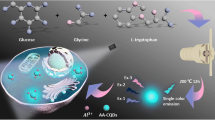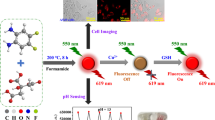Abstract
Carbon quantum dot/carbon dot (CD) exhibiting sustained photoluminescence at longer wavelengths in aqueous solution is difficult to prepare, but has enormous potential in biomedical applications. For the first time, we report the magnesium(II) selective fluorescence enhancement of a red-light emitting anthrarufin and boric acid-derived CD in aqueous solution for direct evaluation of creatine kinase (CK) enzyme activity. The CD displayed visually detectable, intense red fluorescence only in the presence of magnesium ion (Mg2+) at physiological pH value when irradiated with an ultraviolet (UV) source. Concurrently, a significant increase in steady-state fluorescence intensity and fluorescence lifetime was documented. A time-dependent density functional theory (TD-DFT) analysis displayed a bathochromic shift in UV-visible (vis) absorption, and increased oscillator strength of transition resulting from the selective chelation of Mg2+ with β-hydroxy keto functionality on the surface of the CD. The CD-Mg2+ assembly was subsequently used to conceptualize the detection of CK directly through the exploration of the differential binding affinity of Mg2+ with adenosine triphosphate (ATP), adenosine diphophate (ADP), and CD that is otherwise not possible with commercially available kits as of today. Thus, the report delineated here usher grandeur potential of CD for biological explorations related to Mg2+ or ATP sensing and monitoring of Mg2+-dependent enzymatic activity through a clear understanding of the chemistry.

Similar content being viewed by others
References
Hassan, M.; Gomes, V. G.; Dehghani, A.; Ardekani, S. M. Engineering carbon quantum dots for photomediated theranostics. Nano Res.2018, 11, 1–41.
Yuan, F. L.; Li, S. H.; Fan, Z. T.; Meng, X. Y.; Fan, L. Z.; Yang, S. H. Shining carbon dots: Synthesis and biomedical and optoelectronic applications. Nano Today2016, 11, 565–586.
Zheng, X. T.; Ananthanarayanan, A.; Luo, K. Q.; Chen, P. Glowing graphene quantum dots and carbon dots: Properties, syntheses, and biological applications. Small2015, 11, 1620–1636.
Zhang, J.; Yu, S. H. Carbon dots: Large-scale synthesis, sensing and bioimaging. Mater. Today2016, 19, 382–393.
Zu, F. L..; Yan, F. Y.; Bai, Z. J.; Xu, J. X.; Wang, Y. Y.; Huang, Y. C.; Zhou, X. G. The quenching of the fluorescence of carbon dots: A review on mechanisms and applications. Microchim. Acta2017, 184, 1899–1914.
Semeniuk, M.; Yi, Z. H.; Poursorkhabi, V.; Tjong, J.; Jaffer, S.; Lu, Z. H.; Sain, M. Future perspectives and review on organic carbon dots in electronic applications. ACS Nano2019, 13, 6224–6255.
Gao, D.; Liu, X. L.; Jiang, D. L.; Zhao, H.; Zhu, Y. D.; Chen, X. Q.; Luo, H. R.; Fan, H. S.; Zhang, X. D. Exploring of multicolor emissive carbon dots with novel double emission mechanism. Sens. Actuators, B: Chem.2018, 277, 373–380.
Wang, H.; Sun, C.; Chen, X. R.; Zhang, Y.; Colvin, V. L.; Rice, Q.; Seo, J.; Feng, S. Y.; Wang, S. N.; Yu, W. W. Excitation wavelength independent visible color emission of carbon dots. Nanoscale2017, 9, 1909–1915.
Zhu, S. J.; Song, Y. B.; Wang, J.; Wan, H.; Zhang, Y.; Ning, Y.; Yang, B. Photoluminescence mechanism in graphene quantum dots: Quantum confinement effect and surface/edge state. Nano Today2017, 13, 10–14.
WZhang, T. X.; Zhu, J. Y.; Zhai, Y.; Wang, H.; Bai, X.; Dong, B.; Wang, H. Y.; Song, H. W. A novel mechanism for red emission carbon dots: Hydrogen bond dominated molecular states emission. Nanoscale2017, 9, 13042–13051.
Yan, F. Y.; Sun, Z. H.; Zhang, H.; Sun, X. D.; Jiang, Y. X.; Bai, Z. J. The fluorescence mechanism of carbon dots, and methods for tuning their emission color: A review. Microchim. Acta2019, 186, 583.
Cheng, J.; Wang, C. F.; Zhang, Y.; Yang, S. Y.; Chen, S. Zinc ion-doped carbon dots with strong yellow photoluminescence. RSC Adv.2016, 6, 37189–37194.
Fan, Y.; Guo, X. Y.; Zhang, Y. Q.; Lv, Y.; Zhao, J. L.; Liu, X. Y. Efficient and stable red emissive carbon nanoparticles with a hollow sphere structure for white light-emitting diodes. ACS Appl. Mater. Interfaces2016, 8, 31863–31870.
Zhang, H. Y.; Wang, Y.; Xiao, S.; Wang, H.; Wang, J. H.; Feng, L. Rapid detection of Cr(VI) ions based on cobalt(II)-doped carbon dots. Biosens. Bioelectron.2017, 87, 46–52.
Liu, Y. B.; Chao, D. Y.; Zhou, L.; Li, Y. N.; Deng, R. P.; Zhang, H. J. Yellow emissive carbon dots with quantum yield up to 68.6% from manganese ions. Carbon2018, 135, 253–259.
Chen, B. B.; Liu, M. L.; Li, C. M.; Huang, C. Z. Fluorescent carbon dots functionalization. Adv. Colloid Interface Sci.2019, 270, 165–190.
Yang, S. H.; Sun, X. H.; Wang, Z. Y.; Wang, X. Y.; Guo, G. S.; Pu, Q. S. Anomalous enhancement of fluorescence of carbon dots through lanthanum doping and potential application in intracellular imaging of ferric ion. Nano Res.2018, 11, 1369–1378.
Zuo, G. C.; Hu, J. S.; Wang, Y. T.; Xie, A. M.; Dong, W. Dramatic red fluorescence enhancement and emission red shift of carbon dots following Zn/ZnO decoration. Luminescence2019, 34, 759–766.
Mandal, S.; Prasad, S. R.; Mandal, D.; Das, P. Bovine serum albumin amplified reactive oxygen species generation from anthrarufin-derived carbon dot and concomitant nanoassembly for combination antibiotic-photodynamic therapy application. ACS Appl. Mater. Interfaces2019, 11, 33273–33284.
Mandal, S.; Das, P. Ultrasensitive visual detection of mycotoxincitrinin with yellow-light emitting carbon dot and Congo red. Food Chem.2020, 312, 126076.
Du, F. Y.; Yuan, J.; Zhang, M. M.; Li, J. N.; Zhou, Z.; Li, Z.; Cao, M. L.; Chen, J. H.; Zhang, L. R.; Liu, X. et al. Nitrogen-doped carbon dots with heterogeneous multi-layered structures. RSC Adv.2014, 4, 37536–37541.
Sahoo, M.; Sreena, K. P.; Vinayan, B. P.; Ramaprabhu, S. Green synthesis of boron doped graphene and its application as highperformance anode material in Li ion battery. Mater. Res. Bull.2015, 61, 383–390.
Liu, Y. H.; Duan, W. X.; Song, W.; Liu, J. J.; Ren, C. L.; Wu, J.; Liu, D.; Chen, H. L. Red emission B, N, S-co-doped carbon dots for colorimetric and fluorescent dual mode detection of Fe3+ ions in complex biological fluids and living cells. ACS Appl. Mater. Interfaces2017, 9, 12663–12672.
Lu, S. Y.; Sui, L. Z.; Liu, J. J.; Zhu, S. J.; Chen, A. M.; Jin, M. X.; Yang, B. Near-infrared photoluminescent polymer-carbon nanodots with two-photon fluorescence. Adv. Mater.2017, 29, 1603443.
Jana, J.; Ganguly, M.; Chandrakumar, K. R. S.; Rao, G. M.; Pal, T. Boron precursor-dependent evolution of differently emitting carbon dots. Langmuir2017, 33, 573–584.
Kim, Y. H.; Yoon, M.; Cho, D. W.; Jeoung, S. C.; Kim, D. Transient resonance Raman spectra of 1,5-dihydroxyanthraquinone in the lowest excited triplet state. Bull. Korean Chem. Soc.1997, 18, 803–805.
Farruggia, G.; Iotti, S.; Prodi, L.; Montalti, M.; Zaccheroni, N.; Savage, P. B.; Trapani, V.; Sale, P.; Wolf, F. I. 8-Hydroxyquinoline derivatives as fluorescent sensors for magnesium in living cells. J. Am. Chem. Soc.2006, 128, 344–350.
Komatsu, H.; Iwasawa, N.; Citterio, D.; Suzuki, Y.; Kubota, T.; Tokuno, K.; Kitamura, Y.; Oka, K.; Suzuki, K. Design and synthesis of highly sensitive and selective fluorescein-derived magnesium fluorescent probes and application to intracellular 3D Mg2+ imaging. J. Am. Chem. Soc.2004, 126, 16353–16360.
Abrinaei, F. Laser ablation of magnesium in water and investigation of optical nonlinearity by the Z-scan technique. J. Opt. Soc. Am. B2016, 33, 864–870.
Sheng, P. X.; Ting, Y. P.; Chen, J. P.; Hong, L. Sorption of lead, copper, cadmium, zinc, and nickel by marine algal biomass: Characterization of biosorptive capacity and investigation of mechanisms. J. Colloid Interface Sci.2004, 275, 131–141.
Zhao, M. L.; Yang, F.; Xue, Y.; Xiao, D.; Guo, Y. A time-dependent DFT study of the absorption and fluorescence properties of graphene quantum dots. Chem. Phys. Chem.2014, 15, 950–957.
Trapani, V.; Farruggia, G.; Marraccini, C.; Iotti, S.; Cittadini, A.; Wolf, F. I. Intracellular magnesium detection: Imaging a brighter future. Analyst2010, 135, 1855–1866.
Jahnen-Dechent, W.; Ketteler, M. Magnesium basics. Clin. Kidney J.2012, 5, i3–i14.
Baird, M. F.; Graham, S. M.; Baker, J. S.; Bickerstaff, G. F. Creatine-kinase- and exercise-related muscle damage implications for muscle performance and recovery. J. Nutr. Metab.2012, 2012, 960363.
Szasz, G.; Gruber, W.; Bernt, E. Creatine kinase in serum: 1. Determination of optimum reaction conditions. Clin. Chem.1976, 22, 650–656.
Pulido, N. O.; Salcedo, G.; Pérez-Hernández, G.; José-Núñez, C.; Velázquez-Campoy, A.; García-Hernández, E. Energetic effects of magnesium in the recognition of adenosine nucleotides by the F1-ATPase β subunit. Biochemistry2010, 49, 5258–5268.
O’Sullivan, W. J.; Smithers, G. W. Stability constants for biologically important metal-ligand complexes. Methods Enzymol.1979, 63, 294–336.
Zhang, M. R.; Su, R. G.; Zhong, J.; Fei, L.; Cai, W.; Guan, Q. W.; Li, W. J.; Li, N.; Chen, Y. S.; Cai, L. L. et al. Red/orange dual-emissive carbon dots for pH sensing and cell imaging. Nano Res.2019, 12, 815–821.
Chandra, S.; Patra, P.; Pathan, S. H.; Roy, S.; Mitra, S.; Layek, A.; Bhar, R.; Pramanik, P.; Goswami, A. Luminescent S-doped carbon dots: An emergent architecture for multimodal applications. J. Mater. Chem. B2013, 1, 2375–2382.
Acknowledgements
P. D. and R. S. thank the Indian Institute of Technology (IIT) Patna for infrastructural and financial assistance. S. M. and J. P. thank IIT Patna for Institute Research Fellowship.
Author information
Authors and Affiliations
Corresponding author
Electronic Supplementary Material
12274_2020_2927_MOESM1_ESM.pdf
Amplified fluorescence of Mg2+ selective red-light emitting carbon dot in water and direct evaluation of creatine kinase activity
Rights and permissions
About this article
Cite this article
Mandal, S., Pal, J., Subramanian, R. et al. Amplified fluorescence of Mg2+ selective red-light emitting carbon dot in water and direct evaluation of creatine kinase activity. Nano Res. 13, 2770–2776 (2020). https://doi.org/10.1007/s12274-020-2927-1
Received:
Revised:
Accepted:
Published:
Issue Date:
DOI: https://doi.org/10.1007/s12274-020-2927-1




